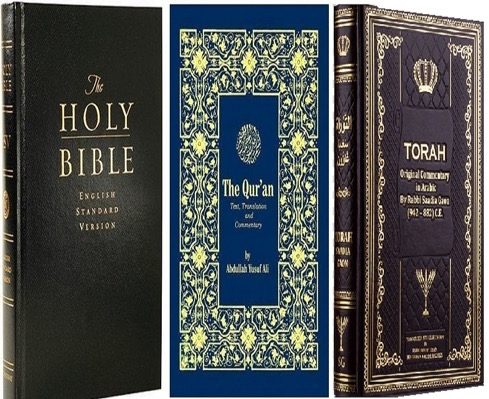Introduction
While the negative role played by extra books of Talmud to undermine Torah was explained but similar role of extra books of the New Testament was just briefly touched in the previous issue of DJ. It is however being further elaborated so that it becomes easy to understand as to why Prophet Muhammad (Pbuh) ordered Muslims not to make Hadith books which would undermine Quran. It’s amazing that the Prophet (Pbuh) imposed restrictions on his own books to promote the Book of Allah, the proof of true Prophethood, while a normal preacher would try to promote himself.
Christian Scriptures
According to the Bible (New Testament) and Quran Jesus Christ was a Jewish Prophet for guidance of the Jews. Jesus Christ conveyed orally to the people what God had originally revealed to him. His disciples, too, propagated it among the people by the spoken words in such a manner that they presented an admixture of their Prophet’s life-story and the verses revealed to Prophet Jesus (Pbuh). None of this material was put into writing during the lifetime of Prophet Jesus Christ (Pbuh) or even in the period immediately following him. It fell to the lot of the Christians whose vernacular was Greek to transform the oral traditions into writing. It must be borne in mind that Christ’s native tongue was Syriac or Aramaic and his disciples, too, spoke the same language. Most Greek-speaking authors heard these traditions in the Aramaic vernacular and committed them to writing in Greek. The oral traditions have been put into writing from Aramaic to Greek from 50-70 C.E.
During the fourth century Four Gospels were selected out of many books in circulation, which are now part of the New Testament. The word ‘gospel’ is derived from the Anglo-Saxon term ‘god-spell’, meaning ‘good story’, a rendering of the Latin ‘evangelium’ and the Greek ‘euangelion’ (Arabic; Injil), meaning ‘good news’ or “good telling”. The Christian Bibles range from the 73 books of the Catholic Church canon, the 66 books of the canon of some denominations or the 80 books of the canon of other denominations of the Protestant Church, to the 81 books of the Ethiopian Orthodox Tewahedo Church canon[1]. The first part of Christian Bibles is the Greek Old Testament, which contains, at minimum, the above 24 books of the Tanakh but divided into 39 (Protestant) or 46 (Catholic) books and ordered differently. The second part is the Greek New Testament, containing 27 books; the four canonical gospels, Acts of the Apostles, 21 Epistles or letters and the Book of Revelation.
The New Testament
The New Testament[2] is the second part of the Christian biblical canon, the first being the Old Testament (also called the Hebrew Bible which includes 5 books of Moses in Torah). The New Testament discusses the teachings and person of Jesus, as well as events in first-century Christianity. Christians regard both the Old and New Testaments together as sacred scripture but consider the New Testament has abrogated the Old Testament, which is a history.
The New Testament is a collection of Christian texts originally written in the Koine Greek language at different times by various different authors. While the Old Testament canon varies somewhat between different Christian denominations, the 27-book canon of the New Testament has been almost universally recognized within Christianity since at least Late Antiquity. Thus, in almost all Christian traditions today, the New Testament consists of 27 books:
1. Four Canonical Gospels (Matthew, Mark, Luke, and John)
2. The Acts of the Apostles
3. Thirteen Epistles of Paul
4. Eight General Epistles, and
5. The Book of Revelation.
The earliest known complete list of the 27 books of the New Testament is found in a letter written by Athanasius, a 4th-century bishop of Alexandria, dated to 367 AD. The 27-book New Testament was first formally canonized during the councils of Hippo (393) and Carthage (397) in North Africa. Pope Innocent I ratified the same canon in 405, but it is probable that a Council in Rome in 382 under Pope Damasus I gave the same list first. These councils also provided the canon of the Old Testament, which included the apocryphal books.
There is no scholarly consensus on the date of composition of the latest New Testament texts. Conservative scholars John A. T. Robinson, Dan Wallace, and William F. Albright dated all the books of the New Testament before 70 AD. But most scholars date some New Testament texts much later than this. For example, Richard Pervo dates Luke-Acts to c. AD 115, and David Trobisch places Acts in the mid-to late second century, contemporaneous with the publication of the first New Testament canon.
The Gospels
The Bible includes four Gospels[3]. The Gospel is any of four biblical narratives covering life, the person, death (according to Christian belief) and the teachings of Prophet Jesus (Pbuh), as he was remembered by the Christian community. Traditionally their authorship (highly speculative) is attributed to Matthew, Mark, Luke, and John (the four evangelists); they are placed at the beginning of the New Testament and make up about half the total text.
Distortion & Corruption of Original Message of Jesus Christ
The New Testament (NT), the Christian holy scripture, has 27 books, only 4 Gospels (Injeels) with some verses attributed to Jesus Christ, while 23 other books have been attributed to St. Paul and other disciples. NT comprises a total 7,959 verses, of which but 1,599 are sayings of Christ. The word count, New Testament is 181,253. However only 36,450 are the words attributed to Christ—barely over 20 per cent. Jesus Christ criticized the clergy and tried to guide them to follow the true teachings of God in the Torah but they turned against him.
Monotheism vs Trinity
It’s amazing that Trinity, the basic doctrine of Christianity, does not appear in Gospels, Jesus Christ never claimed Divinity, rather being a Hebrew Jew he preached strict monotheism, many verses in the Bible verify:
1. “There is ONE God and one mediator between God and man, the HUMAN BEING Messiah Jesus” (1 Tim. 2:5)[4].
2. “I ALONE AM GOD! I AM GOD and there is NONE LIKE ME” [Isaiah 46:9][5]
3. “How can you say, ‘We are wise, And the law of the LORD is with us’? But behold, the lying pen of the scribes made it a lie [Jeremiah 8:8][6]

The Shema Yisrael (Shema “Hear, O Israel”) is a Jewish prayer, and is also the first two words of a section of the Torah, and is the title (better known as The Shema) of a prayer that serves as a centerpiece of the morning and evening Jewish prayer services. The first verse encapsulates the monotheistic essence of Judaism: “Hear, O Israel: the LORD our God, the LORD is one” found in Deuteronomy 6:4. It is repeated by Jesus Christ, the Gospel of Mark 12:29–31 mentions that Jesus of Nazareth considered the opening exhortation of the Shema to be the first of his two greatest commandments and linked with a second (based on Leviticus 19:18b):
“The first of all the commandments is, Hear, O Israel; The Lord our God is one Lord: And thou shalt love the Lord thy God with all thy heart, and with all thy soul, and with all thy mind, and with all thy strength: this is the first commandment. And the second is like, namely this, Thou shalt love thy neighbor as thyself.”
In Luke 10:25-27 the Shema is also linked with Leviticus 19:18. The verses Deuteronomy 6:5 and Leviticus 19:18b both begin with ve’ahavta, “and you shall love”. In Luke’s Gospel, it appears that this connection between the two verses was already part of cultural discussion or practice. However this great monotheistic prayer (Shema) repeated by Jesus Christ was buried under the doctrine of Trinity by Christian theologians through extra writings and explanations.
Jesus Christ, The Prophet
Jesus Christ is mentioned as a Prophet in the Gospels repeatedly but he was raised to the level of divinity through other writings.
And the crowds were saying, “This is the prophet Jesus, from Nazareth in Galilee.” (Matthew 21:11 )
And He said, “Truly I say to you, no prophet is welcome in his hometown. (Luke 4:24)
Adherence to the The Law of Moses
Jesus Christ was adhering to the Law of Moses and perched to follow it.”(Mathew;5:17-20)[7]. In blatant violation of teachings of Jesus Christ, while most Christian theology reflects the view that at least some Mosaic Laws have been set aside under the New Covenant, there are some theology systems that view the entire Mosaic or Old Covenant as abrogated in that all of the Mosaic Laws are set aside for the Law of Christ[8]. However, other theologians do not subscribe to this view, believing that the Law and the Prophets form the basis of Christian living and Christian ethics, and are therefore not abrogated; rather, they can only be understood in their historical context subsequent to the advent of the Messiah. Individuals who believe that Old Covenant laws have been completely abrogated are referred to as antinomians by various Christian traditions, such as the Methodist faith, which teaches that the moral law continues to be binding on the faithful.
The Christian Concept of Revelations
The Christian revelation doctrine is viewed as occurring primarily in the life, teaching, death, and Resurrection of Jesus, all interpreted by the apostolic witnesses under the illumination of the Holy Spirit (Rooh-al-Quds). Commissioned by Jesus and empowered by the divine spirit, the Apostles, as the primary heralds, hold a position in Christianity analogous to that of the prophets in ancient Israel. Christianity has traditionally viewed God’s revelation as being complete in Jesus Christ, or at least in the lifetime of the Apostles. Further development is understood to be a deeper penetration of what was already revealed, in some sense, in the 1st century. Periodically, in the course of Christian history, there have been sectarian movements that have attributed binding force to new revelations occurring in the community, such as the 2nd-century Montanists (a heretical group whose members believed they were of the Age of the Holy Spirit), the 13th-century Joachimites (a mystical group that held a similar view), the 16th-century Anabaptists (radical Protestant sects), and the 17th-century Quakers. In the 19th century, the Church of Jesus Christ of Latter-day Saints (popularly known as Mormons) recognized, alongside the Bible, additional
Holy Spirit (Hebrew: וְר֣וּחַ קָדְשׁ֑וֹ / Ruach Hakodesh) also called Paraclete or Holy Ghost, in Christian belief, the third person of the Trinity. Numerous outpourings of the Holy Spirit are mentioned in the Acts of the Apostles, in which healing, prophecy, the expelling of demons (exorcism), and speaking in tongues (glossolalia) are particularly associated with the activity of the Spirit. In art, the Holy Spirit is commonly represented as a dove. In fact, the New Testament itself is not entirely clear in this regard. One suggestion of such belief is the promise of another helper, or intercessor (paraclete), that is found in the Gospel According to John Pentecost, during which the Holy Spirit descended on the Apostles and other disciples (Acts 2), is seen as the fulfillment of that promise.

Most Catholic and Orthodox Christians have experienced the Holy Spirit more in the sacramental life of the church than in the context of such speculation. The Eastern Orthodox Church has stressed the role of the descent of the Spirit upon the worshipping congregation and upon the eucharistic bread and wine in the prayer known as the epiclesis. Being “filled” with the Holy Spirit is seen as the corollary of one’s salvation. [Britannica][9]
The Holy Spirit is credited with inspiring believers and allowing for them to interpret all the sacred scripture, and leads prophets both in Old Testament and New Testament Christians receive the Fruit of the Holy Spirit by means of his mercy and grace.[10]
Born again, or to experience the new birth, is a phrase, particularly in evangelicalism, that refers to “spiritual rebirth”, or a regeneration of the human spirit. In contrast to one’s physical birth, being “born again” is caused distinctly and separately by baptism in the Holy Spirit, not by baptism in water. It is a core doctrine of the denominations of the Methodist, Quaker, Baptist, and Pentecostal Church along with all other evangelical Christian denominations.[11]
The Comforter (Greek; παράκλητος, Paracletos) is Prophesy of Prophet Muhammad (Pbuh) in Gospel
In the Gospel it is mentioned, Jesus Christ says: :“And I will pray the Father, and he shall give you another Comforter (παράκλητος, par-ak’-lay-tos, Paracletos[12]), that he may abide with you forever.”(John; 14:16)[13]. Prophet Muhammad (Pbuh) delivered the message of God, (Qur’an), which is available to Christians and all the humanity in original uncorrupted form for their peace and comfort for ever, till eternity.
“But when the Counselor comes, whom I shall send to you from the Father, even the Spirit of truth, who proceeds from the Father, he will bear witness to me;” (John; 15:26)[14]. Prophet Muhammad (Pbuh) bore witness of truthfulness of Jesus as messenger of God, he also glorified Jesus Christ. There is a complete Chapter number 19, “Mary” (Surah Mayam) in the Quran[15], no chapter in the Bible. Jesus has been mentioned (25) by name many times more[16] than than Muhammad (4)[17]/ Ahmad (1[18]) in the Quran.
Closeness of Prophet Muhammad (Pbuh) and Jesus (Pbuh): Abu Hurairah (RA) reported that Muhammad (Pbuh) the Messenger of Allah said:
I am most close to Jesus, son of Mary, among the whole of mankind in this worldly life and the next life. They said: Allah’s Messenger, how is it? Thereupon he said: Prophets are brothers in faith, having different mothers. Their religion is, however, one and there is no Apostle between us (between I and Jesus Christ). [Sahih Muslim Hadith # 6132][19]
The Comforter to Come after Jesus Christ: “Nevertheless I tell you the truth; It is expedient for you that I go away: for if I go not away, the Comforter will not come unto you; but if I depart, I will send him unto you.”(John;16:7)[20].
Prophet Muhammad (Pbuh), came six centuries after departure of Jesus Christ. Referring these prophesies to ‘Holy Ghost’ is irrelevant, because as per Christian theology ‘Holy Ghost’ was already present (dove upon Jesus, Luke;3:22[21], John The Baptist filled with the Holy Spirit in mother’s womb, Luke;1:15[22]) and is considered as one of the Trinity. Moreover, what ‘new thing’ ‘Holy Ghost’ has brought after the departure of Jesus Christ in the last 2000 years? (‘Holy Ghost’ is believed to be guiding the Churches).
All these prophesies are clearly applicable to Prophet Muhammad(Pbuh). The Arabic word “Ahmed” or “Muhammad” meaning “the one who praises” or “the praised one” is almost the translation of the Greek word παράκλητος, Paracletos/ par-ak’-lay-tos[23] In the Gospel of John;14:16, 15:26, and 16:7, Jesus (Pbuh) actually prophesized “Ahmed” by name, word ‘Comforter’ in Greek Paracletos, Periclytos refers to Prophet Muhammad(Pbuh).[Names are not to be translated but it has been done in Christian literature].
Allah says in Qur’an:
“Those to whom We have given the Scripture (their scholars) recognize this (Muhammad) as they know their own sons. Those who have lost their own souls refuse therefore to believe.” (Qur’an;6:20)
“And remember, Jesus, the son of Mary, said, ‘O Children of Israel! I am the messenger of Allah (sent) to you, confirming the Law (which came) before me and giving glad tidings of a messenger to come after me, whose name shall be Ahmed.(‘Comforter’ in Greek παράκλητος, (par-ak’-lay-tos)’ But when he came to them with clear signs, they said, ‘This is evident sorcery!”(Qur’an; 61:6)[24]. [For more details see commentary[25] “Tafheem-ul-Quran” by Syed Abu Al’a Maududi)
Ye People of the Book! Why do ye clothe truth with falsehood and conceal the truth while ye have knowledge?” (Qur’an; 3:71).
New Invented Doctrines
The main Christian Doctrines; Trinity, Atonement & Original Sin are the work through distortion of the Bible by doctors of scripture; Jesus Christ did not preach these doctrines, the other 23 books of New Testament, the work of Saint Paul and others helped to create the new Christian theology and doctrines. Creating a new religion and putting the label of a Prophet of God on it does not make it a religion of divine origin.[26]
This is the obvious reason that Prophet Muhammad (Pbuh) and Rightly Guided Caliphs did not approve of any other book (scripture) beside Quran.
How Christianity was Established as a Religion?
In the four gospels we find the personality and teachings of Jesus but very little of the dogmas of the Christian church. It is in the epistles, a series of writings by the immediate followers of Jesus, that the broad lines of Christian belief are laid down. H. G. Wells[27] briefly explains this in his book “A Short History of the World“. Chief among the makers of Christian doctrine was St. Paul. He had never seen Jesus nor heard him preach. Paul’s name was originally Saul and he was conspicuous at first as an active persecutor of the little band of disciples after the crucifixion. Then he was suddenly converted to Christianity, and he changed his name to Paul. He was a man of great intellectual vigour and deeply and passionately interested in the religious movements of the time. He was well versed in Judaism and in the Mithraism and Alexandrian religion of the day. He carried over many of their ideas and terms of expression into Christianity. He did very little to enlarge or develop the original teaching of Jesus, the teaching of the Kingdom of Heaven. But he taught that Jesus was not only the promised Christ, the promised leader of the Jews, but also that his death was a sacrifice, like the deaths of the ancient sacrificial victims of the primordial civilizations, for the redemption of mankind.

When religions flourish side by side, they tend to pick up each other’s ceremonial and other outward peculiarities. Buddhism, for example, in China now has almost the same sort of temples and priests and uses as Taoism, which follows in the teachings of Lao Tse. Yet the original teachings of Buddhism and Taoism were almost flatly opposed. And it reflects no doubt or discredit upon the essentials of Christian teaching that it took over not merely such formal things as the shaven priest, the votive offering, the altars, candles, chanting and images of the Alexandrian and Mithraic faiths, but adopted even their devotional phrases and their theological ideas. All these religions were flourishing side by side with many less prominent cults. Each was seeking adherents, and there must have been a constant going and coming of converts between them. Sometimes one or the other would be in favour with the government. But Christianity was regarded with more suspicion than its rivals because, like the Jews, its adherents would not perform acts of worship to the God Caesar. This made it a seditious religion, quite apart from the revolutionary spirit of the teachings of Jesus himself.
St. Paul familiarized his disciples with the idea that Jesus, like Osiris, was a god who died to rise again and give men immortality. And presently the spreading Christian community was greatly torn by complicated theological disputes about the relationship of this God Jesus to God the Father of Mankind. The Arians taught that Jesus was divine, but distant from and inferior to the Father. The Sabellians taught that Jesus was merely an aspect of the Father, and that God was Jesus and Father at the same time just as a man may be a father and an artificer at the same time; and the Trinitarians taught a more subtle doctrine that God was both one and three, Father, Son and Holy Spirit. For a time it seemed that Arianism would prevail over its rivals, and then after disputes, violence and wars, the Trinitarian formula became the accepted formula of all Christendom. It may be found in its most complete expression in the Athanasian Creed.
Throughout the first two centuries after Christ, the Christian religion spread throughout the Roman Empire, weaving together an ever-growing multitude of converts into a new community of ideas and will. The attitude of the emperors varied between hostility and toleration. There were attempts to suppress this new faith in both the second and third centuries; and finally in 303 and the following years a great persecution under the Emperor Diocletian came about. The considerable accumulations of Church property were seized, all bibles and religious writings were confiscated and destroyed, Christians were put out of the protection of the law and many were executed. The destruction of the books is particularly notable. It shows how the power of the written word in holding together the new faith was appreciated by the authorities. Christian church was mainly instrumental in preserving the tradition of learning.
The persecution of Diocletian failed completely to suppress the growing Christian community. In many provinces it was ineffective because the bulk of the population and many of the officials were Christian. In 317 an edict of toleration was issued by the associated Emperor Galerius, and in 324 Constantine the Great, a friend and on his deathbed a baptized convert to Christianity, became sole ruler of the Roman world. He abandoned all divine pretensions and put Christian symbols on the shields and banners of his troops. In a few years Christianity was securely established as the official religion of the empire. The competing religions disappeared or were absorbed with extraordinary celerity and in 390 Theodosius the Great caused the great statue of Jupiter Serapis at Alexandria to be destroyed. From the outset of the fifth century onward the only priests or temples in the Roman Empire were Christian priests and temples.[28]
Disagreements among Christians
The evolved doctrines and teachings have not been accepted by many Christians right from the outset, 2000 years ago. There have always been Christians who read Gospels (Injeel) and cling to the original message of Jesus Christ and oppose the concocted extra biblical doctrines. Thomas Jefferson[29] (1743 – 1826) was one of such persons. He was an American statesman, diplomat, lawyer, architect, philosopher, and Founding Father who served as the third president of the United States from 1801 to 1809.
Thomas Jefferson and his Bible
In the White House, Washington, D.C. 1804, Thomas Jefferson attempted to extract an authentic Jesus from the Gospel accounts and the result was “The Jefferson Bible”[30]. Thomas Jefferson was frustrated. It was not the burdens of office that bothered him. It was his Bible. Jefferson was convinced that the authentic words of Jesus written in the New Testament had been contaminated. Early Christians, overly eager to make their religion appealing to the pagans, had obscured the words of Jesus with the philosophy of the ancient Greeks and the teachings of Plato. These “Platonists” had thoroughly muddled Jesus’ original message. Jefferson assured his friend and rival, John Adams, that the authentic words of Jesus were still there. The task, as he put it, was one of abstracting what is really his from the rubbish in which it is buried, easily distinguished by its luster from the dross of his biographers, and as separate from that as the diamond from the dunghill.
With the confidence and optimistic energy characteristic of the Enlightenment, Jefferson proceeded to dig out the diamonds. Candles burning late at night, his quill pen scratching “too hastily” as he later admitted, Jefferson composed a short monograph titled “The Philosophy of Jesus of Nazareth”. The subtitle explains that the work is “extracted from the account of his life and the doctrines as given by Matthew, Mark, Luke & John.” In it, Jefferson presented what he understood was the true message of Jesus.
Jefferson set aside his New Testament research, returning to it again in the summer of 1820. This time, he completed a more ambitious work, The Life and Morals of Jesus of Nazareth Extracted Textually from the Gospels in Greek, Latin, French and English. The text of the New Testament appears in four parallel columns in four languages. Jefferson omitted the words that he thought were inauthentic and retained those he believed were original. The resulting work is commonly known as the “Jefferson Bible.”[31]

Who was the Jesus that Jefferson found? He was not the familiar figure of the New Testament. Jefferson discovered Jesus who was a great Teacher of Common Sense. His message was the morality of absolute love and service. Its authenticity was not dependent upon the dogma of the Trinity. In short, Mr. Jefferson’s Jesus, modeled on the ideals of the Enlightenment thinkers of his day, bore a striking resemblance to Jefferson himself. [Why Thomas Jefferson Rewrote the Bible Without Jesus’ Miracles and Resurrection?[32] ]
Monotheist Christians – Unitarians not Trinitarians
There is a common perception that Christianity has always been following the doctrines like Trinity, Original Sin, Redemption and Crucifixion of Christ; this is far from the truth. After doctrinal differences with Paul (who never met Jesus Christ), the monotheists like Barnabas (disciple of Jesus Christ) did not sit idle but continued preaching the true message of monotheism of Jesus Christ. The followers of Barnabas never developed a central organization yet due to the truthfulness of simple theology and devotion of their leaders, their number increased very fast. These Christians incurred the wrath of the Church and a systematic effort was made to destroy them and to obliterate all traces of their existence including books and churches. The lesson of history, however, is that it is very difficult to destroy faith by force. Their lack of organization became a source of strength because it was not so easy to pick them up one by one. Later many doctrines and groups appeared inspired by the teachings of Barnabas; however, they avoided mentioning the name of Barnabas due to the fear of persecution.
Monarchianism was a Christian dissent sect that developed during the 2nd and 3rd centuries C.E. It is noticed that up to the 4th century C.E there existed a sect known as Hypisistarians who refused to worship God as father but revered God as an All-Mighty Ruler of the world, He was the Highest of all and no one was equal to Him. Arius (250-336 C.E) is the famous disciple of Lucian of Antioch. No man dared to oppose the organized Church but Arius did, and remained a headache for her whether he was ordained a priest or was excommunicated. During this time some events changed the history of Europe.
Emperor Constantine-I brought a greater part of Europe under his rule and secondly, he began to support the Christians without accepting Christianity. In 325 C.E a meeting of all denominations of Christianity was called at Nicea (Now Isnik, a village). The conference had many prolonged sessions. Emperor Constantine could not grasp the full implications of the ecclesiastical confrontation, but he was very clear in his mind that for maintaining peace in his realm the support and cooperation of the Church was necessary. Accordingly, he threw his weight behind Athanasius and banished Arius from the realm. Thus, the belief of Trinity became the official religion of the empire.
Biblical Unitarianism exist even Now and growing
Presently there is a great movement of Biblical Unitarians. Professor Sir Anthony Buzzard[33] is one of the most persuasive and energetic voices of our day calling for Christians to pursue reformation and restoration of original Christianity. His message is getting popular. Focus on the Kingdom is his theme[34].
The Pauline Christianity
Most of the Christianity practiced can be called as Pauline Christianity or Pauline theology, also called “Paulism ” or “Paulanity”, is the theology and Christianity which developed from the beliefs and doctrines espoused by Paul the Apostle through his writings (14 Epistles/books). Paul’s beliefs were strongly rooted in the earliest Jewish Christianity, but deviated from this Jewish Christianity in their emphasis on inclusion of the Gentiles into God’s New Covenant, and his rejection of circumcision as an unnecessary token of upholding the Law (Shariah). Paul had a strong influence on early Christianity, transmuting Jesus, the Jewish messiah, into the universal savior. This thesis is founded on differences between the views of Paul and the earliest Jewish Christianity, and also between the picture of Paul in the Acts of the Apostles and his own writings. In this view, Paul is to be taken as pro-Hellenization or Romanization.

Some literary critics of Christianity argue that Paul distorted the original and true faith, or claim that Christianity is largely his invention. The former include such secular commentators as the philosophers Friedrich Nietzsche and Bertrand Russell. Nietzsche’s criticisms are based upon his moral objections to Paul’s thought. Other writers, such as Slavoj Zizek and Alain Badiou, also agree with this interpretation, but hold much more positive opinions about Paul’s theological influence. Christian anarchists, such as Leo Tolstoy and Ammon Hennacy, believe Paul distorted Jesus’ teachings. Tolstoy claims Paul was instrumental in the church’s “deviation” from Jesus’ teaching and practices, while Hennacy believed “Paul spoiled the message of Christ.”[35]
Prophet Muhammad (Pbuh), the true Messenger of Allah, warned his Muslim followers 1400 years in clear words
Abū Hurayra said: God’s Messenger (God bless him) came out to us while we were writing ḥadīths, and he said, “What is this that you are writing?” We said,” ‘Ḥadīths we have heard from you.” He said, “Do you want a book other than God’s book? [a kitāban ghayr kitāb illāh turīdūna] The communities before you were only caused to stray by the books they wrote along with God’s book.” Abū Hurayra said, “Then, I said, ‘May we relate ḥadīth [orally] on your authority, oh, messenger of God?’ He said, ‘Yes, there is no harm in relating ḥadīth [orally] on my authority, but anyone who intentionally attributes a lie (to) me should prepare to take his place in the fire.’ [Taqyid Ilm 33][36]
Lessons for Muslims
The brief history of evolution of Christianity, apart from the monotheistic teachings of Jesus Christ, highlights the importance of adherence to the original divine message preached by the Messenger of God. While the non-biblical doctrines were invented to produce a new religion [Pauline Christianity], the original message survives till to date which leads the truth seekers to Islam, making it the fastest growing religion in Europe and USA. There are lessons from the history of previous communities, while Jews created many sects by adding man made voluminous books like Talmud, the Christians added 23 books to Gospels to create New Testament comprising 27 books. This was the reason that Caliph Umar and other Rightly Guided Caliphs (Allah may be pleased with them) only put Quran in writing in the form of a Book and forbade writing Hadith books, in line with Sunnah[37] of the Prophet (Pbuh) and Quran. However, after first century Hijrah, there was deviation from this Sunnah and resultantly we find many sects in Islam. Ignoring the last book of Allah, indulging in “Qeel o Qaal”[38] (unnecessary discussions – (“It was said”- “that was said”), this was the fear expressed by Hazrat Ali (RA) when he also justified the decision of Hazrat Umar (RA).

Conclusion
The message of Jesus Christ which he received from God through revelations was monotheistic and directed to remove corrupt practices of Jewish Rabbis and reform society. However, it was distorted by the later disciples and followers who claimed to receive revelations through dreams, visions, wrote epistles and books to abandon the real teachings of Jesus Christ (Pbuh). This was the main reason mentioned by the Prophet (Pbuh) while prohibiting Hadith writing, which would ultimately turn into Hadith books to undermine and abandon the Quran. The Prophet (Pbuh) did not permit the Companions with scholarly potentials like Abu Musa al-Ashʿari, Abu Hurayra (oral narrator of 5,374 Hadith) , AbdAllah bin ʿAbbas (narrated 2660 Hadiths) , Abd Allah bin Masood (800), Abd Allāh bin Umer (2,630Hadith), Zayd ibn Thabit (92), Abu Said Khudri (1170) (RA) and many others to write even notes. The spirit was well understood by the Rightly Guided Caliphs and pious Companions. The role of Caliph Umar (RA) is very significant though other Caliphs also were of the same view as evident from their Sunnah (acts). Gradually during the 2nd/3rd century Hijrah, the temptation to defy these orders was on the rise, hence new terminologies and theories were invented to raise the level of Hadiths to divine revelations (similar to Quran) to justify Hadith Book writing.
To be continued ……
Next Part-4: Hadith Book ban by the Prophet (Pbuh), adhered to by the Rightly Guided Caliphs, Companions and arguments to defy this ban through newly invented theory of Secret Revelations (Wahi Khafi/ Ghair Matloo[39]) and its Analysis.





